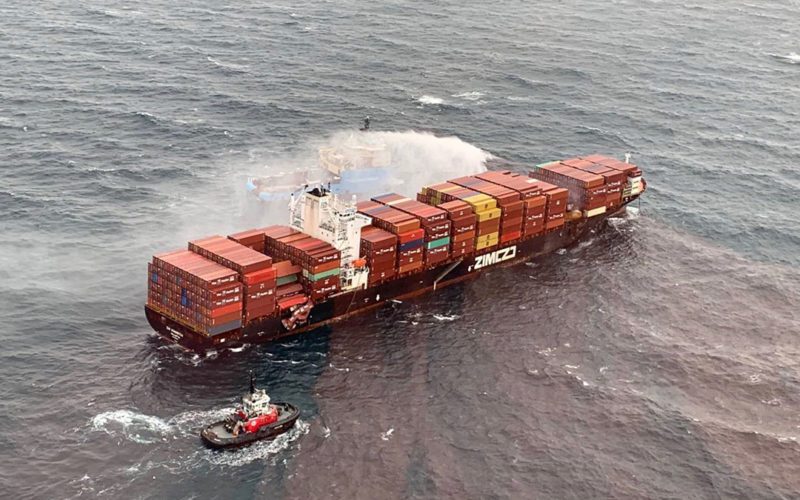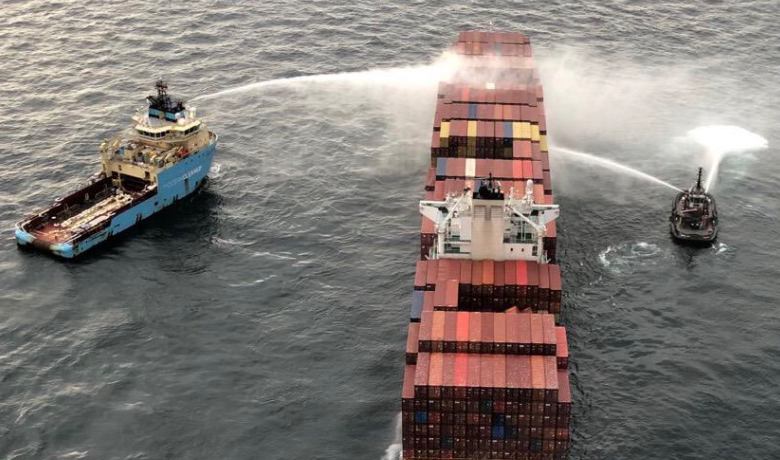
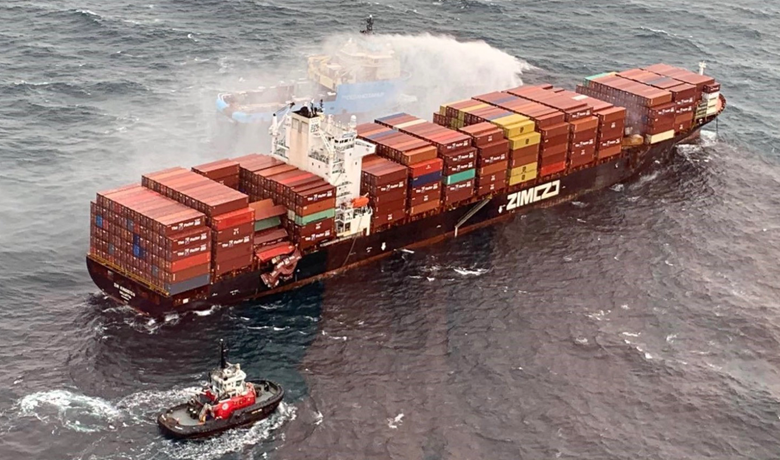
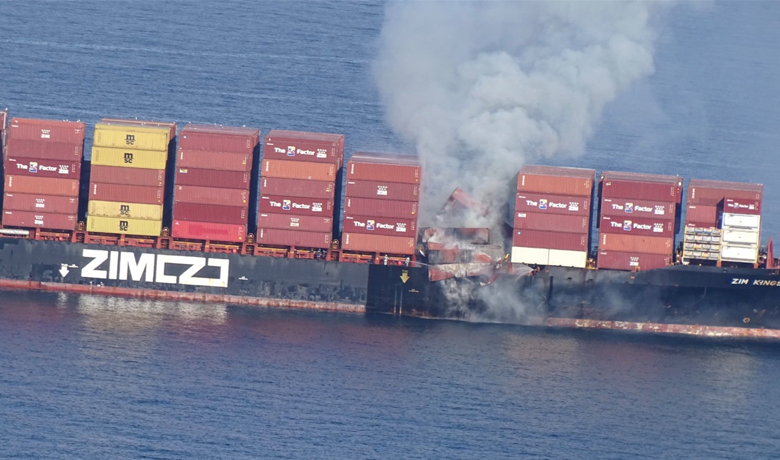
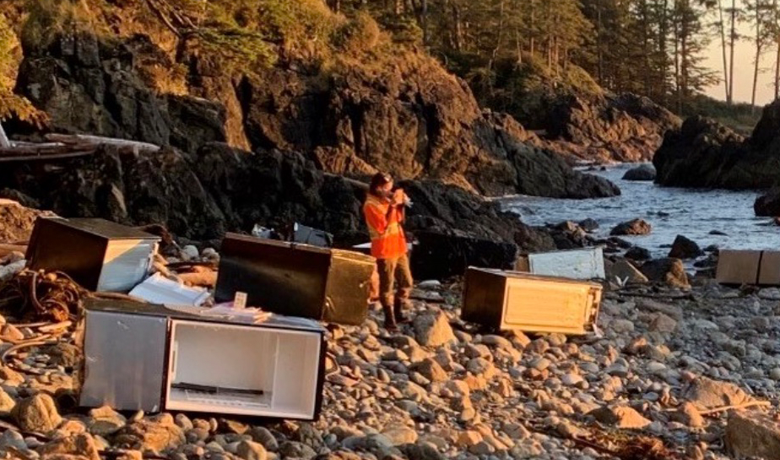
More than 100 containers fell overboard from the cargo ship Zim Kingston as the vessel encountered heavy weather in the Pacific Ocean some 40 miles from the Strait of Juan de Fuca.
A row of containers later caught fire as the 853-foot ship anchored near Victoria, B.C., to assess impacts from the lost containers. Dozens of containers within a single row of cargo were destroyed.
The incident began on the night of Thursday, Oct. 21, when the ship, laboring in heavy weather, lost 109 containers overboard while heeling at a 35-degree angle. Two days after the ship reached anchor, on Oct. 24, crewmembers discovered a fire in bay 14, a stack holding about 100 containers, four rows off the bow.
Several local tugboats responded, and the Canadian rescue vessel Atlantic Raven arrived after 18 hours. Coast Guard officials urged Zim Kingston’s captain to abandon ship. He refused, opting instead to remain aboard with four officers to coordinate the response.
Sixteen other crewmembers left the ship, descending a ladder down the hull to the Canadian Coast Guard lifeboats Cape Calvert and Cape Naden.
At first, firefighters trained water on areas of the ship near the fire, but not on it. They believed the chemicals would burn when brought into contact with seawater. After 12 hours of this, the fire showed no signs of slackening. The captain at 0100 on Oct. 25 urged the tugs to begin putting water on the fire itself. By then, the captain had determined the burning containers held mostly dry goods.
“When the fire started, they were shooting water at the bottom to keep everything cool,” said Michelle Imbeau, spokeswoman for the Canadian Coast Guard.
“Once they knew what was in the containers, they began training their hoses directly on the fire,” Imbeau continued. “Otherwise, it would have made it worse.”
With this change, the battle began to slowly turn, the fire lessened, and was eventually declared under control late on Oct. 25. Smoldering remains kept firefighters engaged for a week.
The U.S. Coast Guard and Canadian Coast Guard responded with firefighting vessels and flyovers from CCG helicopters. No injuries were reported to any crewmembers or responders.
Checking with the ship’s manifest, authorities discovered that two of the lost containers contained dangerous cargo. The ship had been carrying 57 tons of potassium amyl xanthate, used in mines and pulp mills, and thiourea dioxide, used to manufacture textiles, in four containers.
These chemicals are thought to carry a very low risk of poisoning or toxicity because they do not accumulate in the body faster than they are excreted.
The rest of the lost cargo included Christmas decorations, sofas, poker tables, metal car parts, clothing, toys, yoga mats, stand-up paddle boards, industrial parts and other consumer goods. Some of this began to wash up on the shores of Vancouver Island in the coming days.
Meanwhile, the ship’s owners contracted with Resolve Marine Group for salvage operations and firefighting, as well as the recovery of any containers that washed ashore.
Resolve Marine called upon two vessels already on the scene, the offshore supply ships Maersk Tender and Maersk Trader, to assist with the response. A hazardous materials crew from Vancouver also mobilized.
Ultimately, four of the 109 containers that went overboard washed ashore. The remaining 105 are believed to have sunk. One of these was breached and one was damaged. None of them contained the hazardous materials.
By Nov. 1, 71 refrigerators, 81 bags of Styrofoam, 19 bags of garbage and 11 helicopter bags of debris had been removed from Palmerston Beach on the north end of Vancouver Island. Debris removal from Guise Bay also went forward.
By early December, beaches in northern Vancouver Island where debris had been reported were considered clean, according to the Canadian Coast Guard. Teams ultimately collected more than 30 tons of debris from Canadian shores.
Surveys determined that none of the ship’s vital structural or navigational equipment were damaged during either incident. For close to a month, the ship remained anchored at Constance Bank, near Victoria, undergoing cargo stabilization and awaiting a determination on exactly where it would go. Finally, on Dec. 3, the ship transited to Nanaimo, B.C., on Vancouver Island’s east side.
The distance from Constance Bank to the Nanaimo Anchorage is about 86 nautical miles in mostly sheltered waters. Once at Nanaimo, the ship underwent cargo offloading.
“The majority of the stacks are upright,” said Imbeau, “but there are three different bays where the stacks have gone askew or fallen in on each other.”
As of press time, in mid-December, AIS data showed the ship remained in Nanaimo. The cause of the fire in the forward cargo area is under investigation.

